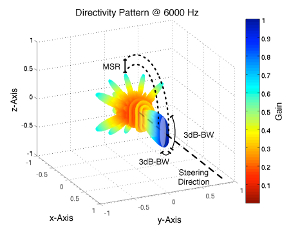Spatial Filtering by Applying State-Of-The-Art Beamformers: The Generalized Eigenvector Beamformer
- Status
- Finished
- Type
- Master Project
- Announcement date
- 06 Jun 2014
- Student
- Nikolaus Fankhauser
- Mentors
- Martin Hagmüller
- Hannes Pessentheiner
- Research Areas

Description
A distant speech recognition system is fundamental for voice-operated ambient assisted living facilities. A common purpose of such a system is to capture the wave field, locate a target, e.g., a speaker in a crowded room, set a focus (a virtual beam) on it, and enhance its speech. The same applies to close-talking systems, e.g., a speaker using a hand-held device in a crowded public transport vehicle.
In both cases, the system consists of several modules, whereas one module is related to spatial filtering, i.e., beamforming. A beamformer exploits directional or positional information provided by a target localizer or tracker. It enables us to spatially filter a wave field captured by a microphone array in, e.g., a room so that we can eliminate signal components of interfering targets or noise sources. The result is an enhanced monaural signal with dominating target signal components and attenuated interfering target or noise components. Such a signal can be fed into, e.g., a word recognizer to transform the target signal into symbols or words.
We are currently working on distant- and close-talking speech recognition applications, where beamforming is an indispensable tool. By now, we’ve evaluated the performances of common beamformers, e.g., the delay and sum (DS) beamformer, the minimum variance distortionless response (MVDR) beamformer, and our recently introduced convex-optimized (CVX) beamformer. However, there is still a bunch of beamformers we have not evaluated yet, e.g., the generalized eigenvector (GEV) beamformer, etc. We need to implement this beamformer to do more comprehensive performance evaluations and to be able to apply more suitable beamformers to specific problems.
Tasks
- Literature review of the GEV beamformer.
- Implementation in MATLAB.
- Evaluation of its performance (speech database and speech recognizer provided).
- Report about beamformer, experiments, and findings (in English).
Your Profile / Requirements
The candidate should be interested in literature reviews (papers), spatial filtering (beamforming), digital signal processing, and MATLAB programming.
References
- Tashev, I., ``Sound Capture and Processing: Practical Approaches,’’ Wiley, August, 2009.
- Kumatani, K., McDonough, J., Raj, B., ``Microphone Array Processing for Distant Speech Recognition: From close-talking microphones to far-field sensors,’’ IEEE Signal Processing Magazine, 29(6):127-140, November, 2012.
